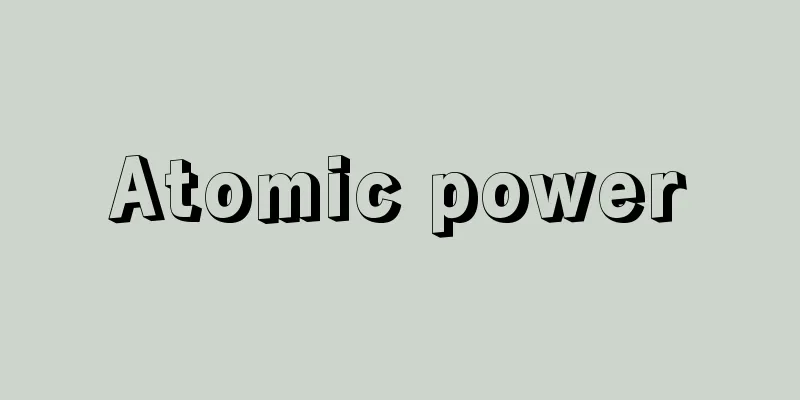Atomic power

|
Energy released during the disintegration or transformation of atomic nuclei, nuclear reactions, etc. It is also called nuclear energy or atomic energy. The fact that a huge amount of energy is hidden inside atomic nuclei was already known in the early 20th century through research on naturally occurring radioactive elements. Einstein's special theory of relativity, published in 1905, clarified the equivalence of mass and energy. In other words, when 1 gram of mass is converted into energy, it becomes 90 terajoules (90 x 1012 J), which is equivalent to the energy needed to keep 30,000 100-watt light bulbs lit for a year (a joule is a unit of work and energy written as J). When an atomic nucleus is formed, part of the mass of the elementary particles that compose it is converted into binding energy and stored inside (hence the mass defect), which is released during the nuclear reaction. It was known from radioactivity research that the magnitude of this reaction can reach millions of times that of chemical reactions. However, the discovery of neutrons, the resulting fission of uranium nuclei, and the discovery of nuclear fission chain reactions made it possible to create a method for causing a large number of nuclear reactions on a macroscopic scale possible. The use of energy based on this fission was first realized in the form of atomic bombs, and later moved on to the use of energy in nuclear power generation and other forms of energy (hereafter, nuclear power generation or nuclear power plants will be abbreviated as nuclear power plants). In addition, nuclear fusion reactions, in which light nuclides such as hydrogen are fused to produce heavy nuclides such as helium, were developed for military purposes in the form of hydrogen bombs. Although research efforts have been ongoing to realize the use of controlled nuclear fusion reactions for civilian purposes, this has not yet been achieved. [Atsunosuke Nakajima and Jun Tateno October 19, 2016] Nuclear fission and chain reactionsEven though the nuclear energy released in a nuclear reaction is millions of times greater per atom than in a chemical reaction, in order to extract it as practically useful energy, a method must be found to make many atoms react sustainably. This reaction was made possible by the discovery of the phenomenon known as nuclear fission. Nuclear fission is the phenomenon in which a heavy atomic nucleus such as uranium is bombarded by a neutron and splits into two nuclei of roughly equal mass. For example, fission occurs as shown in the following formula:
Therefore, one way to create a system (nuclear reactor) that can sustain a continuous fission reaction is to use enriched uranium, which has a higher concentration of the uranium-235 isotope than natural uranium, and to use moderators such as heavy water, light water (ordinary water), and graphite, which are made of light atoms to slow down the speed of neutrons. In order to control the chain reaction, it becomes necessary to appropriately introduce control materials made of atomic nuclei that easily absorb neutrons (such as boron-10 and cadmium), into the system. In addition, in order to cause a chain reaction, the amount of fissile material contained must be increased to a certain level, and the proportion of neutrons that escape from the surface must be reduced. The minimum mass required to sustain this nuclear fission chain reaction is called the critical mass. In the case of an atomic bomb, a chain reaction is suddenly initiated by instantly combining highly enriched uranium or plutonium above the critical mass, releasing a huge amount of energy in an extremely short period of time. In a nuclear reactor, the core is made up of fissile material such as uranium in an amount that exceeds the critical mass. In a nuclear reactor, when a chain reaction is occurring, it is said to be in a critical state, and when it has stopped, it is said to be subcritical. [Atsunosuke Nakajima and Jun Tateno October 19, 2016] History of nuclear power developmentDevelopment of the atomic bombThe discovery of the nuclear fission phenomenon of uranium by O. Hahn and F. Strassmann of Germany in 1938 was an opportunity to directly link nuclear physics and its findings, which had previously been the subject of purely physical interest in the investigation of the ultimate structure of matter, to the practical problem of releasing enormous amounts of nuclear energy. Moreover, because the discovery occurred on the eve of World War II, this enormous amount of energy was to be developed into atomic weapons (nuclear weapons). Research into the development of atomic weapons began in Nazi Germany as early as 1939 and in the UK in 1940. However, as World War II intensified, it became impossible to continue research in the UK, and the UK later joined the US atomic bomb development project. The United States accepted many exiled scientists from the Nazis, including Einstein, Fermi, Szilard, and Wigner, and also had British researchers join the United States. The United States also escaped damage during World War II, and it already had superior industrial and economic power. These factors worked to its advantage, and the United States succeeded in the Manhattan Project (a plan to build an atomic bomb) in secrecy, mobilizing a huge budget of approximately 2 billion dollars (at the time) and tens of thousands of scientists and engineers, and completed three atomic bombs in July 1945. One of these was used in an explosion test in the desert of Alamogordo, New Mexico, on July 16 of that year, and was an implosion-type plutonium atomic bomb. The remaining two were uranium-235 and plutonium atomic bombs, respectively, and the former was dropped on Hiroshima on August 6 of the same year, and the latter on Nagasaki on August 9. During World War II, atomic weapons development research was also underway in the Soviet Union and Japan. After the war, the Soviet Union tested an atomic bomb in 1949, and an aircraft-launched booster atomic bomb using lithium deuterium in 1953. The booster atomic bomb was a layer cake bomb designed by the Soviet Sakharov, which was a bomb with a yield of 500 kilotons, in which nuclear fusion materials were wrapped around the atomic bomb. The United States mistakenly thought of it as a dry hydrogen bomb, but the basis for this had already been formed through research during the war (the Soviet Union successfully tested a Teller-Ulam type hydrogen bomb, which used an atomic bomb as a heat source to cause nuclear fusion in multiple stages, at the Semipalatinsk Test Site on November 22, 1955). In Japan, physicist Yoshio Nishina played a central role in the research, which was conducted at the RIKEN Institute and elsewhere, but Japan was defeated before it could produce any significant results, and the results were scattered. The nuclear technology acquired through the execution of the Manhattan Project was not only used for the production of atomic bombs, but also contained all of the major components that form the backbone of today's nuclear technology system, so I will summarize the main achievements below. The key to producing an atomic bomb ultimately comes down to how to obtain a certain amount of pure plutonium and highly enriched uranium. (1) Plutonium production: Atomic reactors are necessary for the production of plutonium, and for this purpose, he established what would today be called reactor physics and reactor engineering, studying various issues related to nuclear fission chain reactions, such as the escape of neutrons, the action of moderators, the effect of isotope enrichment, and methods of controlling chain reactions. He also built and operated a nuclear reactor, then scaled it up in one go to build and operate a large-scale plutonium production reactor. (2) The development of technology to mass-produce uranium, as well as graphite and heavy water, which are moderators, necessary for nuclear reactor construction. (3) Development of radiation protection measures and health management. (4) Enrichment of uranium isotopes. Various methods for isotope separation, including electromagnetic separation, were examined, and the gas diffusion method was finally successful. (5) Research into nuclear fuel reprocessing technology: The first method for extracting plutonium using precipitation separation was established. [Atsunosuke Nakajima and Jun Tateno October 19, 2016] The Great Militarization After World War IIWith the end of World War II, the United States switched its nuclear development management system from wartime military management to civilian management. In 1946, it adopted the Atomic Energy Act (McMahon Act), and based on that, it established the Atomic Energy Commission (AEC) (January 1947). Internationally, it submitted the Baruch Plan, which aimed to "control" atomic weapons, to the United Nations, but it was not realized due to opposition from the Soviet Union, which wanted the ban on atomic and hydrogen bombs to take priority. The dropping of the atomic bombs on Hiroshima and Nagasaki marked the start of the postwar Cold War between the United States and the Soviet Union, rather than hastening the end of the war, and so the United States expanded its nuclear arsenal in three waves after the war. The first wave began at the same time as the establishment of the civilian-managed AEC, and involved the renovation and expansion of plutonium production facilities and uranium enrichment plants in Hanford, Washington (where the Manhattan Project was promoted), and the development of nuclear submarines was also started. The second wave began with President Truman's order to develop the hydrogen bomb in January 1950 and ended with the completion of the bomb in 1954. It promoted the development of all forms of nuclear weapons and led to the construction of a new uranium enrichment plant in Paducah, Kentucky. The third wave, which lasted from 1952 to 1956 and overlapped with the second wave, was a period in which the development of tactical nuclear weapons was the focus of the pursuit of nuclear armament for the entire military. This led to the construction of a new enrichment plant in Portsmouth, Ohio, and a major expansion of the Hanford plant. The first nuclear submarine, the Nautilus, was launched in 1955. The total cost of the US nuclear arms expansion over these three waves was $13.8 billion (at the time), seven times the cost of the Manhattan Project. This unstoppable nuclear arms expansion policy led to an arms race based on the premise of a "balance of power" between the US and the Soviet Union. Based on this balance, in December 1953, US President Eisenhower announced the famous "Atoms for Peace" plan at the United Nations General Assembly, in which he proposed the provision of stockpiled enriched uranium and the establishment of the International Atomic Energy Agency (IAEA), and America's nuclear strategy was transformed into a comprehensive strategy that also included so-called peaceful uses. [Atsunosuke Nakajima and Jun Tateno October 19, 2016] Beginning of peaceful (civilian) use of nuclear energyThe First International Conference on the Peaceful Uses of Atomic Energy, held in Geneva, Switzerland in the summer of 1955, opened the door to the peaceful use of atomic energy for the first time, and made it possible to disclose information on atomic technology that had been hidden behind a thick wall of military secrecy. This led to an optimistic outlook for the peaceful use of atomic energy spreading worldwide, leading to the establishment of Atomic Energy Commissions in Japan, West Germany, Belgium, Italy, Spain, Brazil, Argentina, and other countries. By this time, five countries had developed nuclear technology: the United States, the United Kingdom, the Soviet Union, France, and Canada. However, none of these countries had completed nuclear power technology that could be exported to other countries, and by the early 1960s, all that was exported was research reactors and isotope-related technology. Only the United Kingdom had announced plans to build a large-scale nuclear power plant using a graphite-moderated, carbon dioxide-cooled reactor (Calder Hall type reactor) fueled by natural uranium, but only Japan and Italy imported it, and these two were the only commercial power reactors that the United Kingdom was able to export. The use of nuclear power plants for electricity production had been restricted by the massive increase in production of cheap Middle Eastern crude oil. In 1963, the Third International Conference on the Peaceful Uses of Atomic Energy (Geneva Conference) was held, and the United States took this opportunity to promote the American-style light water reactor, an improved version of the nuclear submarine reactor (pressurized water reactor: PWR, later to be joined by boiling water reactor: BWR) developed by Hyman George Rickover (1900-1986) for power generation, as "proven," with a guaranteed supply of enriched uranium, and to promote it worldwide. [Atsunosuke Nakajima and Jun Tateno October 19, 2016] The emergence and stagnation of the light water reactor marketIn the United States, after the Third Geneva Conference, General Electric and Westinghouse, based on the technology they had accumulated in developing naval reactors, aimed to compete with new oil-fired power plants by standardizing and mass-producing parts and pursuing economies of scale through larger sizes, thereby lowering the unit price of electricity generation. At the same time, they marketed light water reactors worldwide, using the US government's guarantee of enriched uranium as a weapon. One of the sales methods was the "turn-key" method, which was built to the specifications presented by the seller and could be operated immediately by turning the key, thereby improving convenience and reducing costs. However, with this method, it was difficult to reflect the natural conditions of the construction site in the design, so only a few reactors were built in the early stages. It has been pointed out that the use of the "turn-key" method at the Fukushima Daiichi Nuclear Power Plant led to the expansion of tsunami damage caused by the Tohoku Pacific Ocean Earthquake that occurred in Japan on March 11, 2011, which led to the nuclear accident. Thus, from 1963 onwards, a "light water reactor boom" began in the US. However, this boom did not last long, and by 1976 orders had fallen to almost zero. This slump was further hit by the Three Mile Island (TMI) nuclear accident in 1979. Contracts for nuclear power plants in the US were cancelled and construction was halted, and at the request of the US Congress, concerned about the serious impact on the nuclear industry, the Congressional Office of Technology Assessment published a report in February 1984 entitled "Nuclear Power in an Age of Uncertainty". In the 2000s, a movement to revive nuclear power, known as the "nuclear renaissance", spread, and in the US, the G.W. Bush administration tried to boost new construction, but new construction did not progress. In Germany in 2000, the coalition government of the Social Democrats (SPD) and the Alliance '90/Green Party set course for a nuclear phase-out, including abolishing nuclear power plants 30 years after they were put into operation, but in 2010, the coalition government of the Christian Democrats/Christian Social Union (CDU/CSU) and the Free Democratic Party (FDP) decided to extend the operation period, resulting in a setback in the anti-nuclear policy. However, after the Fukushima Daiichi nuclear accident in Japan in March 2011, the Merkel administration rescinded the extension and decided to immediately shut down eight aging nuclear power plants and gradually shut down the remaining nuclear power plants by 2022. [Atsunosuke Nakajima and Jun Tateno October 19, 2016] Uses of radiation and radioisotopesAn important application of nuclear power other than power generation is the application of radiation and radioisotopes (RI). This is because it has become possible to mass-produce various RIs and radioactive sources such as cobalt-60 ( 60Co ) at low cost using nuclear reactors. According to statistics from fiscal 2015, the number of business establishments in Japan that have permission or notification to use RI or radiation generating devices has reached 7,515. RIs can be divided into sealed and unsealed types. The former are primarily used for measurement purposes, such as in gas chromatograph detectors for nickel-63 ( 63Ni ) and tritium-3 ( 3T ), and as radiation sources for remote medical irradiation devices and level gauges, such as 60Co . Other important sealed radioisotopes include iron-55 ( 55Fe ), cobalt-57 ( 57Co ), krypton-85 ( 85Kr ), strontium-90 ( 90Sr ), cadmium-109 ( 109Cd ), iodine-125 ( 125I ), cesium-137 ( 137Cs ), promethium-147 ( 147Pm ), thulium-170 ( 170Tm ), iridium-192 ( 192Ir ), gold-196 ( 196Au ), americium-241 ( 241Am ), and californium-252 ( 252Cf ). Technetium-99m ( 99mTc ) is the most commonly used unsealed radioisotope. It is a nuclide widely used in nuclear medicine. The daughter nuclide 99mTc is extracted and formulated in hospitals from the parent nuclide molybdenum 99 ( 99Mo ) using a generator (separation operation device). Most of the RI used in Japan is imported from the UK, USA, France, Canada, etc., but a few percent is also produced in Japan. In terms of value, pharmaceuticals for nuclear medicine account for the majority. Nuclear medicine uses can be broadly divided into in vivo use, in which RI is administered into the body as a tracer to examine the function and morphology of specific organs from outside the body, and in vitro use, in which radioimmunoassays that utilize the specificity of antigen-antibody reactions, that is, trace substances in blood and urine are analyzed outside the body in test tubes. In addition, accelerators such as linear accelerators, synchrotrons, cyclotrons, and betatrons are becoming widely used in the treatment of malignant tumors. It has also been applied in a variety of applications, including positron CT diagnosis combined with CT technology, and measurement of tree rings using CT, which uses a sealed RI source instead of an X-ray source. Important practical uses of radiation include the use of irradiation to prevent the germination of potatoes and onions, etc., and the irradiation sterilization of syringes and needles, etc. Although the field of radiation chemistry, which uses the energy of radiation to synthesize and modify polymer compounds, is important in research, it has been difficult to surpass other methods industrially, and the situation is contrary to initial expectations. [Atsunosuke Nakajima and Jun Tateno October 19, 2016] Japan's nuclear power development and mass construction of light water reactorsHistory of the start of nuclear research in JapanUnder the Allied occupation after Japan's defeat in World War II, atomic research was prohibited. However, when the peace treaty came into effect, lively debates were held at forums such as the Science Council of Japan on whether or not atomic research should be started. On March 2, 1954, Yasuhiro Nakasone, then a member of the Progressive Party, suddenly submitted a budget of 235 million yen to the Diet to build a nuclear reactor, and it passed without sufficient deliberation. It is clear today that this move anticipated the shift in American nuclear strategy revealed in President Eisenhower's speech "Atoms for Peace" at the United Nations General Assembly in December of the previous year, which called for the provision of enriched uranium stockpiled for military use, the proposal for the creation of an International Atomic Energy Agency, and the conclusion of bilateral nuclear agreements with various countries. However, coincidentally, March 1 was also the day that the Daigo Fukuryu Maru was damaged by an American hydrogen bomb test in the Bikini waters. This incident sparked a public outcry calling for the banning of atomic and hydrogen bombs in Japan, which swept across the nation like wildfire, and resulted in the collection of over 30 million signatures. Meanwhile, the Science Council of Japan issued a statement in opposition to the reactor budget, which had been submitted without regard for the wishes of scientists, and called for the adoption of the three principles of atomic energy - democracy, autonomy, and openness - as a guarantee that atomic research in Japan would be limited to peaceful uses. These three principles were incorporated into the Atomic Energy Basic Law, which was promulgated in 1955, and the basic stance of atomic energy development in Japan was established. At the same time, the Atomic Energy Commission was launched in 1956, and the Japan Atomic Energy Research Institute (JAEA) and the Atomic Fuel Corporation (JNFL) were established, putting the development system in place. JAEA constructed the research reactors JRR-1 and JRR-2, imported from the United States, with the JRR-1 reaching criticality in September 1957. The domestic production of the JRR-3 reactor, a natural uranium heavy water type, continued, and the JRR-4 reactor was constructed for shielding tests of marine reactors. Japan Nelson Public Corporation also promoted exploration of domestic uranium resources, including Ningyo Pass (on the border between Tottori and Okayama prefectures), and smelting of uranium metal. [Atsunosuke Nakajima and Jun Tateno October 19, 2016] Massive construction of light water reactors and frequent accidents and breakdownsOn the other hand, before there was enough experience in constructing research reactors or operating them, the rush to put nuclear power plants into practical use was pushed forward, and the Japan Atomic Power Company, mainly funded by electric power companies, was established in 1957 to introduce and install a Calder Hall type reactor fueled by natural uranium from the UK. This reactor encountered many design changes and technical difficulties, and it was not until 1967 that the power reactor (Tokai No. 1) installed in Tokai Village, Ibaraki Prefecture, reached full output operation, by which time the introduction of light water reactors had already begun, with construction of Tsuruga No. 1 (Japan Atomic Power Company, April 1966), Fukushima No. 1 (Tokyo Electric Power Company, September 1967), Mihama No. 1 (Kansai Electric Power Company, August 1967), and others starting in succession. The natural uranium reactor route was abandoned after Tokai No. 1, and from then on nine electric power companies competed to introduce American light water reactors that used low-enriched uranium fuel. Subsequently, manufacturers such as Hitachi, Toshiba (both BWRs), and Mitsubishi (PWR) established domestic light water reactor technology based on the imported technology, and construction has continued at a rate of approximately one unit per year since then. However, light water reactors, which were supposed to be technically "proven," suffered a series of breakdowns and accidents in the 1970s and 1980s, and their availability dropped to the 30-40% range. This low reliability raised serious concerns about safety, but the incident of the Japan Analytical Chemistry Institute falsifying environmental radioactivity data, which came to light in January 1974, and the nuclear ship Mutsu's radiation leak and long-term drifting incident in September, exposed the sloppy administration of nuclear safety all at once, forcing a reexamination of Japan's nuclear administration system. In order to overcome this situation, the "Atomic Energy Administration Discussion Group," consisting of members mainly of scholars such as Arisawa Hiromi, Tajima Eizo (1913-1998), and Mukaibo Takashi (1917-2002), was held under the Miki Takeo cabinet, and made proposals for reform of nuclear administration. As a result, the Nuclear Safety Commission was established in October 1978, and the Atomic Energy Basic Act was also revised (the Nuclear Safety Commission was abolished in September 2012, and replaced by the newly established Nuclear Regulation Authority). However, this reform resulted in the Ministry of International Trade and Industry (now the Ministry of Economy, Trade and Industry) gaining control of both promotion and regulation powers, resulting in the loss of regulatory independence. Since then, improvements have been made to reactor materials and operating modes (baseload operation with reduced output fluctuations), which has led to a decrease in accidents and failures such as fuel damage caused by stress corrosion cracking and steam generator tube damage, and the operating rate has improved. Just before the Fukushima Daiichi nuclear accident in 2011, there were 54 commercial nuclear power plants with a total capacity of 48.96 million kilowatts, accounting for 20% of the total generating capacity. [Atsunosuke Nakajima and Jun Tateno October 19, 2016] Power Reactor Development Plan and the Monju AccidentBefore the introduction of light water reactors, Japanese researchers at the Japan Atomic Energy Agency and other institutions aimed to independently develop power reactors (nuclear reactors for power generation), and various types of reactors, such as semi-homogeneous reactors and advanced conversion reactors, were proposed and research was proceeding. However, some industrial circles and politicians who were eager to put nuclear power to practical use were dissatisfied with the attitude of researchers at the Japan Atomic Energy Agency and other institutions who were critical of the large-scale introduction of light water reactors, insisting on independent development and building up from the basics. They rejected these researchers and promoted the "National Project for Power Reactor Development (Fast Breeder Reactor Development)". In 1967, a new organization, the Power Reactor and Nuclear Fuel Development Corporation (DCF), was established by absorbing JNFL. A large amount of money was invested in this project (1 trillion yen by the time the prototype fast breeder reactor "Monju" was completed) and distributed to manufacturers. In December 1995, a sodium leak occurred at "Monju" just before completion. Despite the seriousness of the accident, DCF concealed information about the accident and made false reports, which led to severe public criticism. A series of scandals subsequently led to a comprehensive review of DoN's structure and character, leading to its dissolution in September 1998. The Nuclear Fuel Cycle Development Institute, which was established in October of the same year, took over DoN's operations. Furthermore, in 2005, a series of administrative reforms led to the merger of JAERI and the Nuclear Fuel Cycle Development Institute to form the Japan Atomic Energy Agency. [Atsunosuke Nakajima and Jun Tateno October 19, 2016] Technical and policy difficulties surrounding the nuclear fuel cycleThe nuclear fuel cycle is a series of steps centered around the nuclear reactor, starting with the mining of nuclear raw materials and ending with the treatment and disposal of radioactive waste, which can also be called the "life cycle of nuclear fuel." When thinking of nuclear power as an energy industry, it is necessary to consider the entire nuclear fuel cycle. Various nuclear fuel cycles have been envisioned, but the one that is becoming a reality for the time being is the once-through method adopted by the United States and other countries, in which spent nuclear fuel is disposed of as is (although this is not a cycle, it is sometimes called the once-through cycle), and even with this the outlook for the treatment and disposal of radioactive waste has not yet been determined. Below is a summary of the issues at each stage. (1) Uranium mining and refining According to the biennial publication Uranium: Resources, Production and Demand by the Nuclear Energy Agency (NEA) of the Organization for Economic Cooperation and Development (OECD), the confirmed uranium resources are 5,902,900 tons with mining costs of less than $130 per kgU (2014 edition. Figures are as of January 1, 2013). This figure means that if it is consumed only once through light water reactors, it is a smaller resource than oil resources. After the breeder reactor cycle, which converts uranium 238, which accounts for the majority of the resource, into plutonium, is completed, it will become a resource comparable in size to coal. However, in the nuclear fuel cycle, for example, to obtain 28 tons of replacement fuel per year for a PWR reactor with an electrical output of 1 million kilowatts, 181 tons of natural uranium are needed as raw material for the enrichment plant, which requires the mining of more than 100,000 tons of ore. It should be noted that the annual coal requirement for a coal-fired power plant of the same capacity is approximately 4 million tons, so the weight gain of nuclear fuel is only about 40 times. Also, uranium mining has the potential to cause the greatest radiation damage to humans out of all the nuclear fuel cycle processes, except in the case of a major reactor accident. This is due to the release of radon during mining and radiation damage from the accumulation of tailings. (2) Uranium enrichment Due to the enormous enrichment capabilities developed for the production of nuclear weapons, light water reactors became the mainstream of nuclear power plants. In the early days, gas diffusion methods were mainly used, but centrifugation methods have become the mainstream since the late 1970s. In addition, new methods such as chemical exchange and laser methods are being developed. Since these can be used for military purposes, it is important to note that these are technologies that are directly linked to nuclear proliferation. (3) Nuclear fuel reprocessing The PWR's spent nuclear fuel composition is 96% of uranium remaining (enrichment is 0.8% or more), about 1% is plutonium, and about 3% is nuclear fission product, and the reprocessing process is to separate these three parts. Historically, this process was developed to extract plutonium for nuclear weapons, so it is directly linked to nuclear proliferation. However, in order for nuclear power to become a future energy resource, it will need to establish technology including reprocessing of breeder reactor fuel. Currently, commercial reprocessing of light water reactors is not yet established due to technical limitations and is still profitable. Japan has entrusted most of the reprocessing of spent nuclear fuel generated to France and the UK. The Rokkasho Reprocessing Plant of Nippon Nuclear Fuel Co., Ltd., which began construction in 1993 (Heisei 5), was scheduled to go through active testing (final stage before operation) and then enter full-scale operation after undergoing active testing in 2006 (final stage tests before operation), but as of 2016, the vitrification facility for high-level radioactive waste in the final part broke down and it is difficult to repair, it has not yet begun operation as of 2016. As a result, spent nuclear fuel from nuclear power plants in various locations that were scheduled to be removed to the Rokkasho Reprocessing Plant have nowhere to go and have accumulated in storage facilities within each nuclear power plant facility, and some nuclear power plants have no room for storage facilities. になったんです。 English: The first thing you can do is to find the best one to do. Of the spent nuclear fuel generated in Japan, 5,000 tons of light water reactor fuel and 1,500 tons of gas reactor (Colderhall reactor) fuel were sent to the UK and France for reprocessing overseas. Vitrified materials from high-level radioactive waste generated from these have been returned. 1,310 solidified materials had been returned from France by March 2007, and 8,000 tons of the UK have begun to return from the UK since March 2010. These will be temporarily stored at the High-level Radioactive Waste Management Centre in Rokkasho Village, and will be later disposed of by geological disposal. (5) Plutonium at the reprocessing plant A large amount of plutonium separated and refined at the reprocessing plant has also been accumulated. As of the end of 2014, domestic storage amounts of 10,835 kilograms and overseas storage amounts of 36,974 kilograms, totaling 47,809 kilograms. The fast breeder reactor, which was originally planned to be used, is not operating, and the accumulation amount is increasing. The government is trying to promote the use of this as MOX fuel (a mixed oxide fuel of uranium and plutonium) in light water reactors (plural thermal), but it is not easy to use up all of this. (6) Disposal of low-level radioactive waste When compared to high-level radioactive waste with small volumes, the radioactivity level of low-level radioactive waste is characterized by a large volume. In Japan, over 600,000 drum cans (200 liters) have already been stored as measures. Marine dumping and land disposal were considered, but dumping into the Pacific Ocean has become difficult for political and social reasons, and land disposal is being considered. As of January 2016, approximately 280,000 drum cans have been buried at the Low-level Radioactive Waste Reclamation Center, built in Rokkasho Village, Aomori Prefecture, and is scheduled to be expanded to a scale of 3 million. になったんです。 English: The first thing you can do However, the US Department of Defense has notified the US Navy in charge of passing waters that Shikishima's light armament is insufficient for countermeasures against nuclear jacks. In 2012, the Science Council of Japan issued a response entitled "Disposal of High-Level Radioactive Waste," following a request from the Atomic Energy Commission. Among these, the Science Council of Japan has put a brake on the urgent implementation of geological disposal, citing "a fundamental review of policies regarding the disposal of high-level radioactive waste," and "aware of the limits of scientific and technological capabilities and ensuring scientific autonomy." [Nakajima Atsunosuke and Tateno Jun October 19, 2016] Nuclear Proliferation Issuesになったんです。 English: The first thing you can do is to find the best one to do. Member States must establish a system for measuring and managing nuclear materials, and have the obligation to conclude safeguards agreements, including accepting inspections by the International Atomic Energy Agency. However, India's nuclear explosion experiment in 1974 caused doubts about the effectiveness of the NPT, particularly the shock that the US received. As a result, the US's nuclear non-proliferation policy was significantly strengthened, and especially during the Carter administration, the Nuclear Non-proliferation Act was enacted as a domestic law, and strong regulations were added to the export of nuclear material and nuclear technology, and other countries were called on to cancel the fast breeder reactor program and banning commercial reprocessing. This is why long-term nuclear fuel negotiations between Japan and the US over the operation of the Tokai Reprocessing Plan at the time of the Fune Fune, using the provisions of the Japan-US Nuclear Agreement, which requires US consent when reprocessing enriched uranium provided by the United States, led to long-term nuclear fuel negotiations between Japan and the United States over the operation of the Tokai Reprocessing Plant at the time of the Fune Fune. In addition, with the aim of reevaluating the nuclear fuel cycle internationally from the perspective of preventing proliferation, the International Nuclear Fuel Cycle Evaluation (INFCE) was held from 1977 to February 1980, and 59 countries and six international organizations ultimately participated. The conclusion is typical of iridescent colors, but it is being cited as a new international system for improving and strengthening safeguards, and establishing new international systems such as plutonium storage and used nuclear fuel management. Additionally, the London Guidelines were established in 1975 as a regulatory standard that applies to export nuclear-related materials and materials to non-nuclear-weapon states. The PP Treaty was also opened to sign the agreement in March 1980, and Japan joined in November 1988. The contradictions in the NPT regime, which has left nuclear arms unattended, and in turn, the peaceful use of nuclear energy are only deepening. [Nakajima Atsunosuke and Tateno Jun October 19, 2016] Nuclear safety debate and Fukushima Daiichi nuclear accidentOverseas nuclear power plants that were based on the assumption of severe accident prevention measuresになったんです。 English: The first thing you can do is to find the best one to do. The report was created by American physicist Rasmussen (1927-2003), and claimed that the probability of a person dying in a nuclear accident is smaller than the probability of a meteorite falling. In response, the UCS (Union of Concerned Scientists), a group of American scientists, pointed out that there are many problems, such as not taking into account common factors that cause various safety devices to be destroyed simultaneously in an earthquake or other event. The Fukushima Daiichi nuclear accident caused this common factor accident due to an earthquake or tsunami. At the time, test results revealed that if the coolant inside the reactor leaked due to pipe breakage or other factors (a loss of coolant), the core could not be properly cooled by the emergency core cooling device (ECCS) that cools the core. Furthermore, in 1990, it was pointed out that power outages (station blackout) at a power plant using a probabilistic method can be a major factor in the core melting accident. During the Fukushima Daiichi Nuclear Power Plant accident, station blackout occurred due to loss of external power sources due to earthquakes and the loss of function of emergency diesel generators due to tsunamis caused the station blackout. になったんです。 English: The first thing you can do is to find the best one to do. [Tateno Jun October 19, 2016] Japan was unable to legally regulate strict accident prevention measuresになったんです。 English: The first thing you can do is to find the best one to do. になったんです。 English: The first thing you can do is to find the best one to do. Once the heat is lost, the Fukushima Daiichi Nuclear Power Plant accident occurred due to the combination of factors, such as a light water reactor that moves into the core melting in a short time, a nuclear energy system that releases a large amount of radioactivity when the core melts, and a nuclear energy system that causes serious damage to residents, a power company that handles dangerous goods, and a government and regulatory authorities who have not been aware of it that regulations on the operators. [Tateno Jun October 19, 2016] になったんです。 English: The first thing you can doになったんです。 English: The first thing you can do is to find the best one to do . ▽ "Why do nuclear power plants accidents repeat?" (Iwanami Shinsho)" ▽ "Ichikawa Fujio and Tateno Atsushi, "Radiation around the Earth: Nuclear Fuel Cycle and Nuclear Power Plants" (1986, Otsuki Shoten)" ▽ "Q&A Plutonium" edited by the Japan Scientists' Conference Nuclear Issues Research Committee (1994, Liberta Publishing)" ▽ "Shimizu Shuji, Tateno Atsushi, and Noguchi Kunikazu, "Di-Fuel Fuel, 2000" (1998, Liberta Publishing)" ▽ "Doi Kazumi, "Geological basis that nuclear power plants and "geological disposal" are not possible in the Japanese archipelago" (2014, Joint Publishing)" ▽ "Nuclear Technology" 1-6 (1986-1987, Chikuma Shobo)" ▽ "New edition, supervised by Asada Tadakazu and others Nuclear Handbook (Ohmsha, 1989) [Reference Items] | | | | | | |Nuclear |Nuclear Fuel Cycle Development Agency| |Nuclear Weapons| |Light Water | |Atomic Bomb Drop| | | |Nuclear Power |Nuclear | | | | | |Breeding Reactor|Chernobyl Nuclear Power Plant Accident| | and Fuel Development Agency| |Nishina Yoshio|Japan Atomic Energy Agency|Baluk Proposal| | | Accident|Plutonium|Radioactive Waste|Radio-Radiochemistry| -Radio-Chemical| -Radio-Radio- -Radio-Radio-Radio-Radio-Radio- -Radio-Radio- - Radio-Radio-Radio-Radio- Radio-Radio-Radio- - -Source: Shogakukan Encyclopedia Nipponica About Encyclopedia Nipponica Information | Legend |
|
原子核の崩壊や変換、核反応などに際して放出されるエネルギー。核エネルギーとも原子エネルギーともいう。原子核の中に巨大なエネルギーが潜んでいることは、20世紀の初め天然に存在する放射性元素の研究によってすでに知られていた。1905年に発表されたアインシュタインの特殊相対性理論は質量とエネルギーの同等性を明らかにした。すなわち1グラムの質量がエネルギーに変換されると90テラジュール(90×1012J)のエネルギーとなり、これは100ワットの電球3万個を1年間点灯し続けうるエネルギーに相当する(ジュールはJと表記する仕事およびエネルギーの単位)。 原子核が形成される際には、それを構成する素粒子の質量の一部が結合エネルギーに変換されて内部に蓄積されている(したがって質量欠損が生じている)ので、それが核反応に際して放出される。その大きさは化学反応のそれの数百万倍に達することが放射能の研究で知られていた。しかしマクロなスケールで大量の核反応をおこさせる方法は、中性子の発見と、それによるウラン原子核の核分裂、および核分裂連鎖反応の発見により初めて実現可能となった。この核分裂に基づくエネルギーの利用は、最初は原子爆弾として実現し、のちに原子力発電などのエネルギー利用へと移行した(以下、原子力発電または原子力発電所を略称して原発とよぶ)。また、水素などの軽い核種が融合してヘリウムなどの重い核種が生成される核融合反応は、水素爆弾として軍事利用目的で開発された。制御された核融合反応の民生利用実現は研究努力が続けられてきたが、いまだ達成されていない。 [中島篤之助・舘野 淳 2016年10月19日] 核分裂と連鎖反応核反応に伴って放出される核エネルギーが原子1個当り化学反応の数百万倍であるとしても、実用上有用なエネルギーとして取り出し可能となるためには、多くの原子に持続的に反応を行わせるような方法が発見されなければならない。この反応は核分裂という現象の発見によって実現することとなった。核分裂は、ウランなどの重い原子核が中性子の衝撃を受けて、ほぼ質量の等しい二つの原子核に分裂する現象である。たとえば次式のように分裂する。
したがって、連続的に核分裂反応を持続させるシステム(原子炉)をつくる一つの方向は、天然ウランよりもウラン235の同位体濃度を高めた濃縮ウランを用い、また、中性子の速度を減らすための軽い原子から構成される、重水や軽水(普通の水)、黒鉛などの減速材を用いて、核分裂反応を持続させる方法である。連鎖反応を制御するためには、中性子を吸収しやすい原子核(ボロン10やカドミウムなど)からなる制御材を適切に系内に入れる必要が生ずる。また連鎖反応をおこすためには、含まれる核分裂性物質の量をある程度以上に大きくし、表面から逸出する中性子の割合を小さくしなければならない。この核分裂連鎖反応維持に必要な最小限の質量を臨界量という。原子爆弾の場合には高濃縮ウランあるいはプルトニウムを瞬間的に臨界量以上に合体させることにより連鎖反応を急激に発生させ、きわめて短時間に巨大なエネルギーを放出させる。原子炉においては臨界量を超える量の核分裂性物質であるウランなどで炉心を構成する。原子炉では連鎖反応がおきている場合を臨界状態、停止している場合を未臨界という。 [中島篤之助・舘野 淳 2016年10月19日] 原子力開発の歴史原子爆弾の開発1938年ドイツのO・ハーンとF・シュトラスマンによるウランの核分裂現象の発見は、それまで物質の究極構造の究明という純粋な物理学的興味の対象にすぎなかった核物理学とその成果とを、直接、巨大な核エネルギーの解放という実用問題に結び付ける契機となった。しかもその発見の時期が第二次世界大戦の前夜であったために、この巨大なエネルギーは原子兵器(核兵器)として開発されることになった。 原子兵器開発の研究は、ナチス・ドイツでは早くも1939年から、イギリスでは1940年から開始されていた。しかし第二次世界大戦の激化とともにイギリスでの研究継続は不可能となり、のちにアメリカでの原爆開発計画に合流することになった。 アメリカは、アインシュタイン、フェルミ、シラード、ウィグナーをはじめ多くのナチスに追われた亡命科学者を受け入れたこと、イギリスの研究陣が合流したこと、またその国土が第二次世界大戦中の戦災を免れたこと、もともと卓越した工業力と経済力をもっていたことなどが有利に働いて、極秘のうちにおよそ20億ドル(当時)の巨費と十数万の科学者・技術者を動員したマンハッタン計画(原爆製造計画)に成功して、1945年7月に3個の原子爆弾を完成させることができた。うち1個は同年7月16日ニュー・メキシコ州アラモゴードの砂漠での爆発実験に使用されたが、これは爆縮型のプルトニウム原爆であった。残り2個はそれぞれウラン235原爆とプルトニウム原爆であったが、前者が同年8月6日広島に、後者が8月9日長崎に投下された。 ソ連および日本でも第二次世界大戦中に原子兵器開発研究は進められていた。ソ連は大戦後の1949年には原爆を、1953年には重水素化リチウムを用いた航空機搭載可能なブースター原爆を実験した。ブースター原爆は、ソ連のサハロフが設計したレイヤー・ケーキ爆弾とよばれる、核融合材料を原爆に包み込んだ威力500キロトン相当の爆弾であり、アメリカはこれを乾式水爆と誤認するが、その基礎はすでに大戦中の研究により形成されたものである(ソ連が原子爆弾を熱源として多段階式に核融合をおこさせるテラー・ウラム型の水爆実験に成功したのは、1955年11月22日セミパラチンスク実験場においてであった)。日本では物理学者の仁科芳雄(にしなよしお)が中心となり、理化学研究所などで研究が行われたが、みるべき成果をあげる前に敗戦を迎え、成果も四散してしまった。 マンハッタン計画の遂行によって獲得された原子力技術は、原爆製造のためだけでなく、今日の原子力技術体系の骨格をなす主要な部分をすべて含んでいるといえるので、以下におもな成果を要約しておくこととする。原爆製造の鍵(かぎ)はつきつめていえば、純粋のプルトニウムと高濃縮ウランの一定量をいかにして入手するかに帰着する。 (1)プルトニウムの生産 プルトニウムの生産には原子炉が必要であり、このために核分裂連鎖反応に関する次のような諸問題――中性子の逸出、減速材の作用、同位体濃縮の効果、連鎖反応制御の方法などを研究する、要するに今日の用語でいえば原子炉物理学および原子炉工学を創設し、かつまた実際に原子炉を建設し作動させたこと。ついでそれを一挙にスケール・アップして大型のプルトニウム生産炉を建設・運転させたこと。 (2)原子炉建設に必要なウラン、減速材である黒鉛や重水などを大量に製造する技術を開発したこと。 (3)放射線からの防護手段の開発と健康管理。 (4)ウラン同位元素の濃縮 電磁分離法をはじめ、あらゆる同位体分離法が検討され、ガス拡散法を最後に成功させたこと。 (5)核燃料再処理技術の研究 沈殿分離法によるプルトニウムの抽出法が最初に確立されたこと。 [中島篤之助・舘野 淳 2016年10月19日] 第二次世界大戦後の大軍拡第二次世界大戦の終了とともにアメリカは原子力開発管理体制を戦時中の軍管理から文民管理に切り換えた。すなわち1946年に原子力法(マクマホン法)を採択し、それに基づいて原子力委員会(AEC)を発足させた(1947年1月)。国際的には原子兵器の「管理」を目ざすバルーク案を国連に提出したが、原水爆禁止を優先せよというソ連の反対で実現しなかった。広島・長崎への原爆投下は大戦の終結を早めたというよりは、戦後の米ソ冷戦の開始を示すものであったから、アメリカは戦後になってかえって3波にわたる核軍備の大拡張を行うこととなる。第一波は文民管理のAECの発足と同時に開始され、ワシントン州ハンフォード(マンハッタン計画が推進された地)のプルトニウム生産施設とウラン濃縮工場の改修と拡張が行われ、原子力潜水艦の開発もスタートした。第二波は1950年1月の大統領トルーマンによる水爆開発命令に始まり、1954年の水爆完成に終わる時期で、あらゆる形態の核兵器開発が促進され、ケンタッキー州パデューカに新鋭ウラン濃縮工場が建設された。第三波は1952年から1956年までで、第二波と重なっており、この時期には戦術核兵器の開発を重点に全軍核武装化が追求された。このためオハイオ州ポーツマス新濃縮工場の建設やハンフォード工場の大拡張が行われた。第一号原子力潜水艦ノーチラスは1955年に就航している。アメリカがこの3波にわたる核軍拡に注ぎ込んだ費用は138億ドル(当時)に上り、マンハッタン計画の7倍という膨大なものであった。この止めどもない核軍拡政策は、米ソの「力の均衡」を前提にした軍拡競争へと導いていった。この均衡を前提に、1953年12月アメリカ大統領アイゼンハワーは国連総会で有名な「平和のための原子Atoms for Peace」(「平和のための原子力」ともいう)計画を発表し、備蓄した濃縮ウランの供与と、国際原子力機関(IAEA)の創設を提唱し、アメリカの核戦略はいわゆる平和利用をも含む総合的戦略へと変貌(へんぼう)することとなった。 [中島篤之助・舘野 淳 2016年10月19日] 原子力平和利用(民生利用)の開始1955年の夏にスイスのジュネーブで開かれた第1回原子力平和利用国際会議は、初めて原子力の平和利用への扉を開き、軍事機密の厚い壁に遮られていた原子力技術情報の公開を実現した。このため原子力の平和利用に関する楽天的な見通しが世界的に広まり、日本、西ドイツ、ベルギー、イタリア、スペイン、ブラジル、アルゼンチンなどの国々がそれぞれ原子力委員会を創設するに至った。このときまでに原子力技術を開発していた国は、アメリカ、イギリス、ソ連、フランス、カナダの5か国であった。しかし、いずれの国も他国に輸出できる原発技術を完成させていたわけではなく、1960年代前半までに輸出されたのは研究用原子炉やアイソトープ関連技術であった。ただイギリスだけが天然ウランを燃料とする黒鉛減速炭酸ガス冷却型原子炉(コールダーホール型原子炉)による大規模な原発の建設計画を発表していたが、それを輸入したのは日本とイタリアのみで、またこのわずか2基のみが、イギリスの輸出できた商業発電炉であった。 原発の電力生産への利用は、安価な中東原油が大増産されたために抑制されていた。1963年、第3回原子力平和利用国際会議(ジュネーブ会議)が開かれたが、この機会にアメリカは、濃縮ウランの供給保証付きで、リコーバーHyman George Rickover(1900―1986)の開発した原子力潜水艦の舶用炉(加圧水型原子炉:PWR。後に沸騰水型原子炉:BWRが加わる)を発電用に改良したアメリカ型軽水炉が「実証済みproven」であることを宣伝し、世界的売り込みを図った。 [中島篤之助・舘野 淳 2016年10月19日] 軽水炉市場の創出と停滞アメリカでは、第3回ジュネーブ会議以後、ゼネラル・エレクトリック社、およびウェスティングハウス社などは、海軍用原子炉の開発で蓄積した技術を基礎に、さらに新鋭石油火力発電所との競争を目標として、部品の規格化と量産化、大型化によるスケール・メリットの追求などの手法により発電単価の切下げを図り、同時にアメリカ政府の濃縮ウラン供給保証を武器に、世界的に軽水炉の売り込みを行った。売り込みの手法の一つとして「ターン・キー」方式がある。これは売り手の提示した仕様で建設し、キーを回せばすぐに稼動できるというもので、これによって利便性とコストダウンが図られた。しかしこの方式では、建設地の自然条件などを設計に反映することが困難であるため、初期に建設された数基にとどまった。なお、福島第一原発では「ターン・キー」方式を採用していたため、2011年(平成23)3月11日に日本で発生した東北地方太平洋沖地震に伴う津波被害が拡大し、原発事故につながったという指摘もなされている。 こうして1963年以降、アメリカでは「軽水炉ブーム」が巻き起こされる。しかしこのブームは長くは続かず、1976年には発注はほとんどゼロにまで落ち込むこととなる。この低迷にいっそう打撃を与えたのが1979年のスリー・マイル島(TMI)原発事故であった。アメリカ国内での原発の契約のキャンセルや建設中止はその後も続き、原子力産業界への深刻な影響を憂慮したアメリカ議会の要請により、同議会技術評価局は1984年2月に「不確実性の時代における原子力発電」と題する報告書を公表した。2000年代に入り「原子力ルネサンス」とよばれる原発復権の動きが広がり、アメリカではG・W・ブッシュ政権による新規建設へのてこ入れがなされたが、新設は進まなかった。 ドイツでは2000年、社会民主党(SPD)と90年連合・緑の党との連立政権は、稼動後30年の原発廃止等、脱原発に向けての舵(かじ)をきったが、2010年、キリスト教民主・社会同盟(CDU・CSU)と自由民主党(FDP)連立政権は稼動期間の延長を決めるなど、脱原発派政策は後退した。しかし、2011年3月に日本で福島第一原発事故が起きると、メルケル政権は期間延長を撤回、8基の老朽化原発の即時停止、2022年までに残りの原発についても順次停止を決定した。 [中島篤之助・舘野 淳 2016年10月19日] 放射線とラジオ・アイソトープの利用原子力の発電以外への応用として重要な分野は、放射線やラジオ・アイソトープ(RI)の応用である。原子炉を用いて、さまざまのRIやコバルト60(60Co)などの放射線源などを大量廉価に生産できるようになったからである。2015年度の統計では、日本のRIまたは放射線発生装置の使用許可・届出事業所数は7515か所に上っている。 RIの使用形態は密封RIと非密封RIとに分けられる。前者ではニッケル63(63Ni)やトリチウム3(3T)などのガスクロマトグラフの検出器などへの利用のような計測的用途や、遠隔照射医療装置やレベル計用の60Coなどの線源としての用途がおもなものである。その他の重要な密封RIは、鉄55(55Fe)、コバルト57(57Co)、クリプトン85(85Kr)、ストロンチウム90(90Sr)、カドミウム109(109Cd)、ヨウ素125(125I)、セシウム137(137Cs)、プロメチウム147(147Pm)、ツリウム170(170Tm)、イリジウム192(192Ir)、金196(196Au)、アメリシウム241(241Am)、カリホルニウム252(252Cf)などである。これに対し非密封RIで使用量のもっとも多いのはテクネチウム99m(99mTc)である。核医学的に広く利用される核種で、親核種であるモリブデン99(99Mo)から、ジェネレーター(分離操作装置)を使って病院内で娘(むすめ)核種である99mTcを抽出・製剤化して用いる。国内で使用されているRIの大部分はイギリス、アメリカ、フランス、カナダなどからの輸入品であるが、日本でも数%程度が生産されている。金額的には核医学用の医薬品が大部分を占めている。核医学利用を大別すれば、RIをトレーサーとして体内に投与し、体外から特定臓器などの機能や形態を調べるインビボin vivo使用法と、抗原抗体反応の特異性を利用するラジオイムノアッセイ、すなわち血中や尿中の微量物質を体外で、試験管中で分析するインビトロin vitro使用法とになる。また、直線加速器、シンクロトロン、サイクロトロン、ベータトロンなどの加速器が悪性腫瘍(しゅよう)の治療などに広く用いられるようになりつつある。またCT技術と結合させたポジトロンCT診断、密封RI線源をX線源のかわりに用いるCTでの樹木の年輪の測定など、さまざまに応用されている。 放射線の利用としては、ジャガイモ、タマネギなどの発芽防止のための照射利用や、注射筒・針などの照射滅菌が実用上重要なものである。放射線のエネルギーを高分子化合物の合成や改質などに利用する放射線化学の分野は、研究としては重要であるにもかかわらず、工業的には他の方法を凌駕(りょうが)することが困難で、当初の期待とは反する状況にある。 [中島篤之助・舘野 淳 2016年10月19日] 日本の原子力開発と軽水炉の大量建設日本における原子力研究開始の経緯第二次世界大戦敗戦後の連合軍の占領下では原子力研究は禁止されていたが、講和条約の発効とともに日本学術会議などの場で原子力研究を開始すべきか否かをめぐる論争が活発に行われた。1954年(昭和29)3月2日、当時改進党に所属した中曽根康弘(なかそねやすひろ)により原子炉築造予算2億3500万円が突如国会に提出され、十分な審議もなされぬままに国会を通過した。この動きが、前年12月の国連総会でのアメリカ大統領アイゼンハワーによる演説「平和のための原子」として明らかにされたアメリカの核戦略の転換、すなわち軍事用に備蓄された濃縮ウランの提供、国際原子力機関創設の提唱、各国との原子力双務協定締結を内容とする政策変更を先取りしたものであったことは、今日では明らかである。しかし偶然にも3月1日は第五福竜丸がビキニ水域においてアメリカの水爆実験によって被災した日でもあった。この事件を契機に、日本の原水爆禁止を求める世論は燎原(りょうげん)の火のように全国民を巻き込み、3000万を超える署名が集まることとなる。一方、日本学術会議は、科学者の意向を無視して提出された原子炉予算に反対するとともに、日本の原子力研究が平和利用に限られる保証として民主・自主・公開の原子力三原則を要求する声明を発表した。1955年に公布された原子力基本法にこの三原則が取り入れられ、日本の原子力開発の基本姿勢が確立した。1956年には同時に原子力委員会が発足し、日本原子力研究所(原研)、原子燃料公社(原燃)などが設立されて開発体制が整えられた。原研では研究用原子炉JRR‐1炉およびJRR‐2炉をアメリカから導入建設し、JRR‐1炉は1957年9月臨界に達した。引き続き天然ウラン重水型のJRR‐3炉の国産化が進められ、舶用炉の遮蔽(しゃへい)試験用としてJRR‐4炉も建設された。原燃公社による人形峠(鳥取・岡山県境)をはじめとする国内ウラン資源の探査や、ウラン金属の製錬なども進められた。 [中島篤之助・舘野 淳 2016年10月19日] 軽水炉の大量建設と事故・故障の多発しかし一方では、研究炉の建設や運転経験の蓄積すら十分でない段階で、性急な原発の実用化が推進され、イギリスから天然ウランを燃料とするコールダーホール型原子炉を導入設置するために、主として電気事業者の出資による日本原子力発電(株)が設立された(1957)。この炉は多くの設計変更や技術的困難に遭遇し、茨城県東海村に設置された発電炉(東海1号炉)が全出力運転に到達したのは1967年であり、そのときはすでに軽水炉の導入時代に入り、敦賀(つるが)1号炉(日本原電、1966年4月)、福島1号炉(東京電力、1967年9月)、美浜(みはま)1号炉(関西電力、1967年8月)などが相次いで着工された。天然ウラン炉路線は東海1号炉だけで放棄され、以後は低濃縮ウラン燃料を用いるアメリカの軽水型炉を9電力各社が競って導入する。その後、日立(ひたち)、東芝(以上BWR)、三菱(みつびし)(PWR)などのメーカーが導入技術を基に軽水炉国産技術を確立し、以後毎年ほぼ1基の割合で建設が進められた。 しかし技術的に「実証済み」であったはずの軽水炉は1970年代~1980年代に相次ぐ故障・事故に悩まされ、稼動率は30~40%台にまで低下した。この信頼性の低さは安全性への深刻な懸念を引き起こしたが、1974年1月に暴露された日本分析化学研究所の環境放射能データ捏造(ねつぞう)事件、9月に起こった原子力船「むつ」の放射線漏れ事故と長期間の漂流事件は、原子力安全行政のずさんさを一挙に暴露することとなり、日本の原子力行政体制の再検討を余儀なくさせた。このような状況を打開すべく、三木武夫(みきたけお)内閣の下で、有沢広巳(ありさわひろみ)、田島英三(たじまえいぞう)(1913―1998)、向坊隆(むかいぼうたかし)(1917―2002)など学者を中心とするメンバーによる「原子力行政懇談会」が開催され、原子力行政の改革に関する提言を行った。その結果1978年10月、原子力安全委員会が新設され、原子力基本法の改正も行われた(原子力安全委員会は2012年9月に廃止され、新設の原子力規制委員会に移行)。しかしながらこの改革では通商産業省(現、経済産業省)が推進と規制の二つの権限を掌握する結果となり、規制の独立性が失われることになった。 その後、原子炉材料の改良、運転モードの改善(出力変動を抑えたベースロード運転)などが行われ、応力腐食割れなどによる燃料破損、蒸気発生器細管破損などの事故・故障は減少し、稼動率も向上した。なお、2011年の福島第一原発事故直前には商用原発は54基4896万キロワットと、総発電容量の20%を占めるに至った。 [中島篤之助・舘野 淳 2016年10月19日] 動力炉開発計画ともんじゅ事故軽水炉が導入される以前、原研などの日本の研究者は、動力炉(発電用原子炉)の自主的な開発を目ざしており、半均質炉、新型転換炉など、さまざまな炉型が提案され、研究が進められていた。しかし、原子力の実用化を急ぐ産業界や政治家の一部は、自主開発・基礎からの積み上げを主張して軽水炉の大量導入に批判的な原研などの研究者の姿勢に不満をもち、これを排除して、「動力炉開発(高速増殖炉開発)のナショナル・プロジェクト」を推進。1967年には原燃を吸収合併した新組織、動力炉・核燃料開発事業団(動燃)が設立された。このプロジェクトには大量の資金が投じられ(高速増殖炉原型炉「もんじゅ」完成までに1兆円)、メーカーへと配分された。1995年(平成7)12月、完成直前の「もんじゅ」でナトリウム漏れ事故が発生した。事故の重大さにもかかわらず、動燃は事故情報の秘匿や虚偽報告を行ったため、厳しい世論の批判を浴びた。その後も相次ぐ不祥事に動燃のあり方や体質の全面的見直しが進められ、1998年9月に解団。同年10月発足の核燃料サイクル開発機構が動燃の事業を引き継いだ。さらに2005年、一連の行政改革によって原研と核燃料サイクル開発機構は統合し、日本原子力研究開発機構となった。 [中島篤之助・舘野 淳 2016年10月19日] 核燃料サイクルをめぐる技術的・政策的困難原子炉を中心に、核原料物質の採鉱に始まり、放射性廃棄物の処理・処分に終わる「核燃料のライフ・サイクル」ともいうべき一連の段階を核燃料サイクルという。原発をエネルギー産業として考える場合には、核燃料サイクルの全体について考察する必要がある。さまざまな核燃料サイクルが構想されているが、当面現実化しつつあるのはアメリカなどが採用しているワンス・スルーとよばれる使用済み核燃料をそのまま処分してしまう方法で(これはサイクルではないがワンス・スルー・サイクルとよばれることがある)、これとても放射性廃棄物の処理・処分の見通しが確定したわけではない。以下に各段階の問題点を要約しておく。 (1)ウランの採鉱と精錬 経済協力開発機構(OECD)の原子力機関(NEA)が2年ごとに刊行している『ウラン:資源、生産、需要』によれば、ウランの確認資源量はKgU(キログラム・ウラン)当り採掘コスト130ドル以下の資源が590万2900トンであった(2014年版。数値は2013年1月1日時点)。この数値は、軽水炉などのワンス・スルーだけで消費されるとするなら、石油資源よりも小さい資源であることを意味する。資源の大部分を占めるウラン238をプルトニウムに変換する増殖炉サイクルが完成してのち、石炭に匹敵する大きさの資源になるであろう。ただし、核燃料サイクルで、たとえば100万キロワットの電気出力のPWR炉の年間取替え燃料28トンを得るには、181トンの天然ウランが濃縮工場の原料として必要であり、そのためには10万トン以上の鉱石の採掘が必要である。同出力の石炭焚(だ)き火力発電所の年間石炭所要量はほぼ400万トンであるので、核燃料の重量利得は40倍程度にとどまることに留意すべきである。また、ウランの採鉱は、原子炉の重大事故の場合を除けば、核燃料サイクル中最大の放射線障害を人間に与える可能性がある。それは採鉱に伴うラドンの放出や、尾鉱(選鉱くず)の蓄積に基づく放射線障害などがその原因となる。 (2)ウラン濃縮 核兵器製造用に開発された巨大な濃縮能力により、軽水炉が原発の主流となった。初期にはおもにガス拡散法が用いられていたが、1970年代後半からは遠心分離法が主流となっている。また、化学交換法、レーザー法などの新方法が開発されつつある。これらはいずれも軍事目的に転用可能なことから、核拡散に直結する技術であることに注目する必要がある。 (3)核燃料再処理 PWRの使用済み核燃料の組成は、96%が燃え残りウラン(濃縮度は0.8%以上)、約1%がプルトニウム、約3%が核分裂生成物であり、この三つの部分を分離するのが再処理の工程である。歴史的には核兵器用プルトニウムを抽出するために開発された工程であることから、核拡散に直結していることになる。しかし原子力が未来のエネルギー資源となるためには増殖炉燃料の再処理を含む技術の確立が必要となるであろう。現在は、軍用あるいは低燃焼度のガス炉燃料などを除き、軽水炉の商業用再処理は、技術的に未確立で、採算的にも困難に遭遇している。日本は発生した使用済み核燃料の再処理の大部分をフランス、イギリスに委託していた。1993年(平成5)に着工した日本原燃(株)の六ヶ所(ろっかしょ)再処理工場は、2006年アクティブ試験(操業前の最終段階の試験)を経て、本格操業に入る予定であったが、最終部分の高レベル放射性廃棄物ガラス固化施設が故障し、その修理が困難であるため、2016年時点においても操業開始に至っていない。このため、六ヶ所再処理工場に搬出を予定していた各地の原発の使用済み核燃料は行き場を失い、各原発施設内の貯蔵施設に蓄積しており、原発によっては貯蔵施設の余裕がなくなったものも出ている。 (4)高レベル放射性廃棄物の処理・処分 高レベル放射性廃棄物の最終処分の方法は未確立である。軍事利用のためにすでに蓄積された高レベル放射性廃棄物の量は、蓄積される平和利用のそれの10倍を超えると推定されている。これらは現在大部分が鋼製タンクに貯蔵されたままである。再処理後の廃液をガラス固化体とし、ステンレス容器などに封入する方法が採用されている。国際学術連合会議(ICSU。現、国際科学会議)は最終処分法として安定な地層(岩体)への埋設について留意すべき事項を勧告しているが、地層への熱影響を緩和するために、100年程度の中間貯蔵(地上での)を推奨している。これは、再処理を行わず、使用済み核燃料のまま貯蔵する場合にも適用できる。いずれにせよ、もっとも困難な問題は、科学的に安定な閉じ込めが予見されえたとしても、社会的受容が得られるか否かにある。 日本で発生した使用済み核燃料のうち、軽水炉燃料5000トンおよびガス炉(コルダーホール型原子炉)燃料1500トンが、イギリスおよびフランスに送られ海外再処理が行われた。これらから発生した高レベル放射性廃棄物のガラス固化体が返還されている。フランスからは2007年3月までに1310本の固化体が返還済みであり、イギリスからは2010年3月以降、8000トンの返還が始まっている。これらは一時的に六ヶ所村の高レベル放射性廃棄物管理センターに保管され、のちに地層処分されることになっている。 (5)再処理工場のプルトニウム 再処理工場で分離精製されたプルトニウムもまた大量に蓄積されている。2014年末時点で、国内保管分1万0835キログラム、海外保管分3万6974キログラム、合計4万7809キログラムあり、本来使う予定であった高速増殖炉が稼動していないため、行き場を失って蓄積量が増加している。政府はこれをMOX燃料(ウラン・プルトニウムの混合酸化物燃料)として軽水炉で燃やすこと(プルサーマル)を推進しようとしているが、これを使い切ることは容易ではない。 (6)低レベル放射性廃棄物の処理・処分 容積の小さい高レベル放射性廃棄物と対比すれば、低レベル放射性廃棄物の放射能レベルは低いかわりに容積が大きいことが特徴である。日本でも、2008年3月末時点ですでに60万本を超えるドラム缶(200リットル入り)が貯蔵されている。海洋投棄と陸地処分が方策として考えられていたが、太平洋への投棄は政治的・社会的理由で困難となり、陸地処分が検討されている。2016年1月時点で、青森県六ヶ所村に建設された低レベル放射性廃棄物埋設センターには、約28万本のドラム缶が埋設され、最終的には300万本規模に拡張される予定となっている。 (7)輸送問題 たとえば核燃料サイクルの各段階は、実際には輸送手段で結ばれている。とくに使用済み核燃料の海外輸送、返還される高レベル放射性廃棄物固化体などの高放射性物質や、プルトニウムの輸送などは、核拡散防止問題も絡んで複雑な社会問題となっている。1984年夏に生じた六フッ化ウランを積んだモン・ルイ号(フランス)の沈没は、秘密のベールに包まれていた核物質輸送の危険性の一端を明らかにした。また、1987年2月に核物質防護に関する条約(核物質防護条約。核物質防護はフィジカル・プロテクションphysical protectionといい、略称はPP)が発効し、プルトニウムの輸送などに対しては厳重な防護措置が必要となった。こうして1992年11月フランスから約1トンのプルトニウムを積んだ輸送船「あかつき丸」の護衛のために、新たに海上保安庁の巡視船「しきしま」が163億円を投じて建造された。しかし「しきしま」の軽武装では核ジャック対策には不十分であるとして、通過海域の担当アメリカ海軍にアメリカ国防省が万一の場合の対応を通達したという。 2012年、日本学術会議は原子力委員会からの審議依頼を受けて、「高レベル放射性廃棄物の処分について」と題する回答を発表した。このなかで日本学術会議は「高レベル放射性廃棄物の処分に関する政策の抜本的見直し」「科学・技術的能力の限界の認識と科学的自律性の確保」などをあげて、地層処分の実施を急ぐことにブレーキをかけている。 [中島篤之助・舘野 淳 2016年10月19日] 核拡散問題原子力技術の開発が軍事利用から始まった歴史が示すように、いわゆる平和利用技術の世界的拡散は必然的に核情報と核分裂性物質の拡散をも意味する。核兵器保有国も、アメリカ、ロシア(ソ連時代を含む)、イギリス、フランス、中国の5か国のほか、1974年にインド、1998年にはインドとパキスタン、2006年には北朝鮮(朝鮮中央通信が発表)が相次いで核実験を行うなど増加しつつある。1970年にアメリカとソ連(当時)の合意のもとに核不拡散条約(NPT)が成立し、2015年2月時点では191か国が加盟するに至った。しかし同条約は一方で核兵器保有国に核軍縮の実行を義務づけてはいるものの、米ソ間の核軍拡競争(核兵器の垂直拡散)はとどまるところを知らず、他方では核拡散(水平拡散)のおそれがあるとして非核兵器国の原子力平和利用にさまざまな制限を設ける結果となるという大きな矛盾を内包している。加盟国は核物質の計量管理制度を設けるとともに、国際原子力機関の査察を受け入れることなどを内容とする保障措置協定を締結する義務を負わねばならない。しかし1974年インドの行った核爆発実験はNPTの有効性に疑問を抱かせることとなり、とくにアメリカの受けた衝撃は大きかった。その結果アメリカの核不拡散政策は著しく強化され、とくにカーター政権時代になると核不拡散法が国内法として制定され、核物質や核技術の輸出に強い規制が加えられるとともに、高速増殖炉計画の中止や商業再処理の禁止などが各国に呼びかけられた。アメリカの提供する濃縮ウランを再処理する場合にはアメリカの同意が必要という日米原子力協定の条項を盾に、動燃(当時)の東海再処理工場の運転をめぐって日米間で長期にわたる核燃料交渉が行われるに至ったのもそのためである。また核燃料サイクルを核拡散防止の観点から国際的に評価し直すことを目的として、国際核燃料サイクル評価会議(INFCE:International Nuclear Fuel Cycle Evaluation)が1977年から1980年2月にかけて開かれ、最終的には59か国、6国際機関が参加した。その結論は玉虫色の典型ともいうべき内容であるが、保障措置の改良や強化、プルトニウム貯蔵や使用済み核燃料管理などの新国際制度を設けることなどがうたわれている。 このほか核関連物質・資材などの非核兵器国への輸出に際して適用される規制規準として1975年にロンドン・ガイドラインが定められた。またPP条約が1980年3月に署名のため開放され、日本は1988年11月に加入した。 核軍拡を放置したままのNPT体制、ひいては原子力平和利用の矛盾は深まる一方である。 [中島篤之助・舘野 淳 2016年10月19日] 原子力安全論争と福島第一原発事故シビアアクシデント対策を前提としていた海外の原発1960年代後半から大量に原発が建設されたアメリカでは、1970年代初頭に原発をめぐる環境問題・安全論争が激化した。1971年コロンビア特別区の控訴裁判所は、原子力委員会(AEC)が国家環境政策法(NEPA:The National Environmental Policy Act)に違反しており、原発建設に際しては環境影響評価書を提出すべきであるとの判決を下した(メリーランド州にあるカルバート・クリフス原発建設に伴う裁判であったことから、「カルバート・クリフス判決」とよばれる)。AECはこれに従ったが、クラス9とよばれる巨大事故についての評価書は提出しなかった。クラス9事故は、のちにシビアアクシデント(過酷事故)とよばれるようになる。環境保護庁(EPA:Environmental Protection Agency)はクラス9事故に対しても提出するよう求めたため、AECはこのような事故はきわめてまれにしか起きないことを証明する必要に迫られた。このようにしてつくられたのがラスムッセン報告である。同報告は、アメリカの物理学者ラスムッセンNorman Carl Rasmussen(1927―2003)が作成したもので、原発事故で人が死ぬ確率は、隕石(いんせき)の落下によって死ぬ確率よりも小さいと主張されていた。これに対して、アメリカの科学者団体「憂慮する科学者同盟」(UCS:Union of Concerned Scientists)は、同報告では、地震などで各種安全装置が一斉に破壊される共通要因事故を考慮していないなど、多くの問題があることを指摘した。福島第一原発事故ではまさに、地震・津波によりこの共通要因事故が発生した。 また当時、配管破断などで原子炉内の冷却材が漏出した場合(冷却材喪失事故)に、炉心を冷却する緊急炉心冷却装置(ECCS)によってかならずしもうまく炉心冷却ができない可能性があるという試験結果が発表され大きな問題となった(ECCS問題)。さらに1990年、確率論の手法を用いて発電所の停電(ステーション・ブラックアウト)が炉心溶融事故の大きな要因になりうることが指摘された。福島第一原発事故では、地震による外部電源の喪失、津波による非常用ディーゼル発電機の機能喪失でステーション・ブラックアウトが起き炉心溶融に至った。 このように安全論争や研究に基づく警告がなされるなかで、現実に1979年スリー・マイル島原発事故、1986年チェルノブイリ原発事故の二つのシビアアクシデントが発生した。シビアアクシデントとは設計基準事故(設計者があらかじめ事故を想定しこれに対応するために設置した安全装置で収束できる事故)を超えて、炉心に重大な損傷を生じる事故である。この二つの事故を受けて、アメリカやヨーロッパでは、シビアアクシデント対策の重要性が強調され、その対応が法制化されるに至った。これまでの多重防護の三層の壁(異常発生の防止、異常の事故への拡大防止、事故の影響を最小限に食い止める)に加えて、シビアアクシデント対策の二層の壁(著しい炉心損傷防止、放射能の放出抑制・避難など)を加えた五層の壁(レベル)をもつ深層防護に基づく安全対策の法規制が行われるようになった。このようにして世界の原発はシビアアクシデントの発生を前提にして稼動している。 [舘野 淳 2016年10月19日] シビアアクシデント対策の法的規制ができなかった日本各地に原発が建設されるようになる1970年代初頭、日本でもその安全性をめぐって多くの議論が行われた。軽水炉の大量導入・建設を批判した原研などの研究者の発言に対して政府・原研当局は強権的抑圧を行い、人事考課などでこれを組織的に排除したが、これが、福島第一原発事故後に「原子力村」として厳しく批判された、日本の、異論を排除した推進体制、産官学癒着体制へとつながっていく。さらに、日本科学者会議、高木仁三郎(じんざぶろう)(1938―2000)を中心とした原子力資料情報室や、京都大学原子炉実験所の研究者、あるいは各地の住民組織などが、安全性に問題を抱え、放射性廃棄物の処分を先送りしたままの軽水炉の拡大路線に対して、さまざまな批判を行った。政府は形式的な公聴会を開催して住民の意見を聞くなどの措置をとりながら、原発の拡大を着々と進めていった。 1988年から1990年、規制問題などを検討していた原子力安全委員会・共通問題懇談会の席上で、スリー・マイル島原発事故、チェルノブイリ原発事故ののち海外の動向を考慮した学者グループが、シビアアクシデント対策を日本でも取り入れて法整備を行うことを提案したが、東京電力・関西電力などの事業者が強硬に反対したため、法的規制としては実施できず、事業者の自主対応に任せることとなった。法的規制のもと、シビアアクシデント対策が十分になされていれば、福島第一原発事故の際にどれほど被害を減らすことができたかは、一概にはいえないが、少なくとも注水や格納容器ベントによる減圧などがより速やかにできて、炉心損傷に至らなかった可能性もゼロではなかったと考えられる。国会事故調査報告書はこのような規制のあり方を、「東電・電事連の〈虜(とりこ)〉となった規制当局」と表現している(東電は東京電力、電事連は電気事業連合会の略)。 いったん熱の制御を失うと、短時間で炉心溶融へと突き進む軽水炉という原子炉、炉心溶融が起きると大量の放射能が放出され、住民が重大な被害を受ける原子力というエネルギーシステム、危険物を扱いながら、その自覚のなかった電気事業者、その事業者に対する規制を怠った政府・規制当局、こうした要因が重なって福島第一原発事故は発生したということができるだろう。 [舘野 淳 2016年10月19日] 『リチャード・ローズ著、神沼二真・渋谷泰一訳『原子爆弾の誕生――科学と国際政治の世界史』上下(1993・啓学出版)』▽『リチャード・ローズ著、小沢千重子・神沼二真訳『原爆から水爆へ――東西冷戦の知られざる内幕』上下(2001・紀伊國屋書店)』▽『憂慮する科学者同盟(UCS)編・日本科学者会議原子力問題研究委員会訳『原発の安全性への疑問――ラスムッセン報告批判』(1979・水曜社)』▽『川上幸一著『原子力の光と影――20世紀を演出した技術』(1993・電力新報社)』▽『中島篤之助・安斎育郎著『原子力を考える』(1983・新日本出版社)』▽『日本科学者会議編『原子力発電――知る・考える・調べる』(1985・合同出版)』▽『桜井淳著『原発事故の科学』(1992・日本評論社)』▽『吉岡斉著『原子力の社会史――その日本的展開』(1999・朝日選書)』▽『舘野淳・野口邦和・青柳長紀著『徹底解明 東海村臨界事故』(2000・新日本出版社)』▽『佐藤一男著『改訂 原子力安全の論理』(2006・日刊工業新聞社)』▽『舘野淳著『廃炉時代が始まった この原発はいらない』復刊版(2011・リーダーズノート)』▽『山崎正勝著『日本の核開発 1939~1955――原爆から原子力へ』(2011・績文堂出版)』▽『原子力技術史研究会編『福島事故に至る原子力開発史』(2015・中央大学出版部)』▽『武谷三男編『原子力発電』(岩波新書)』▽『高木仁三郎著『原発事故はなぜくりかえすのか』(岩波新書)』▽『市川富士夫・舘野淳著『地球をまわる放射能――核燃料サイクルと原発』(1986・大月書店)』▽『日本科学者会議原子力問題研究委員会編『Q&A プルトニウム』(1994・リベルタ出版)』▽『清水修二・舘野淳・野口邦和編『動燃・核燃・2000年』(1998・リベルタ出版)』▽『土井和巳著『日本列島では原発も「地層処分」も不可能という地質学的根拠』(2014・合同出版)』▽『W・マーシャル編・住田健二監訳『原子力の技術』1~6(1986~1987・筑摩書房)』▽『浅田忠一他監修『新版 原子力ハンドブック』(1989・オーム社)』 [参照項目] | | | | | | | | | | | | | | | | | | | | | | | | | | | | | | | | | | | | | | | | | | | | | | |出典 小学館 日本大百科全書(ニッポニカ)日本大百科全書(ニッポニカ)について 情報 | 凡例 |
>>: Atomic weight - genshiryo (English spelling) atomic weight
Recommend
Butterflyfish - Butterflyfish
A general term for fish of the family Chaetodontid...
Glass ceramics
…Ceramic materials made by crystallizing glass us...
Oncidium cheirophorum (English name) Oncidiumcheirophorum
…[Koichi Ejiri]. … *Some of the terminology that ...
Nobel Industries Ltd.
An explosives manufacturing company whose predeces...
Yanagiya Ko-san - Yanagiya Ko-san
Rakugo performer. (1) The first: A student of the ...
Kobo - Kobo
A perennial grass of the grass family found in hil...
Young pine tree
The castle town of the Mutsu National Diet Buildin...
Ahab - Ehab
…Ishmael, despairing of life on land, boards the ...
Aircraft carrier
〘 noun 〙 (abbreviation of "aircraft carrier&q...
I Ching - Ekigaku
A hermeneutic of the Book of Changes, one of the ...
Nagasaki Road
A modern trunk road in Kyushu, also known as the N...
Lissemys punctata (English spelling) Lissemyspunctata
...The Lissemys subfamily consists of three gener...
Kinzaek College of Technology
...Founded in October 1946 on the vast site at th...
Chemical evolution
This refers to the earliest stage in the evolution...
"Eternal Music Variations"
...Kumiuta koto music is considered to have origi...









